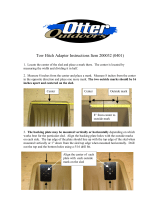
Removing a memory module........................................................................................................................................43
Installing a memory module.......................................................................................................................................... 44
Support bracket...................................................................................................................................................................45
Removing the support bracket....................................................................................................................................45
Installing the support bracket.......................................................................................................................................46
Expansion cards................................................................................................................................................................... 47
Removing the expansion card riser 1...........................................................................................................................47
Installing the expansion card riser 1............................................................................................................................. 48
Removing the expansion card riser 2..........................................................................................................................49
Installing the expansion card riser 2............................................................................................................................ 50
Removing an expansion card........................................................................................................................................ 51
Installing an expansion card..........................................................................................................................................54
Removing the riser card................................................................................................................................................57
Installing the riser card..................................................................................................................................................59
M.2 riser ...............................................................................................................................................................................60
Removing the M.2 riser................................................................................................................................................ 60
Installing the M.2 riser....................................................................................................................................................61
M.2 SSD module..................................................................................................................................................................62
Removing the M.2 SSD module...................................................................................................................................62
Installing the M.2 SSD module.....................................................................................................................................62
Linking board and PCIe cable.............................................................................................................................................63
Removing the linking board and PCIe cable...............................................................................................................63
Installing the linking board and PCIe cable................................................................................................................. 64
Processor and heat sink..................................................................................................................................................... 65
Removing the heat sink................................................................................................................................................ 65
Removing the processor...............................................................................................................................................66
Installing the processor.................................................................................................................................................68
Installing the heat sink...................................................................................................................................................70
OCP cards............................................................................................................................................................................ 72
Removing the OCP filler............................................................................................................................................... 72
Installing an OCP card...................................................................................................................................................72
Removing an OCP card.................................................................................................................................................73
Installing the OCP card filler......................................................................................................................................... 74
System battery.................................................................................................................................................................... 75
Replacing system battery............................................................................................................................................. 75
System board....................................................................................................................................................................... 77
Removing the system board.........................................................................................................................................77
Installing the system board ..........................................................................................................................................78
Trusted Platform Module................................................................................................................................................... 80
Upgrading the Trusted Platform Module................................................................................................................... 80
Initializing TPM for users............................................................................................................................................... 81
Initializing the TPM 1.2 for users...................................................................................................................................81
Initializing the TPM 2.0 for users.................................................................................................................................82
Chapter 6: Jumpers and connectors............................................................................................... 83
System board connectors.................................................................................................................................................. 83
System board jumper settings...........................................................................................................................................84
Disabling a forgotten password......................................................................................................................................... 84
4
Contents




















